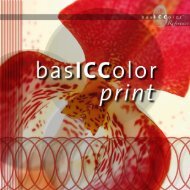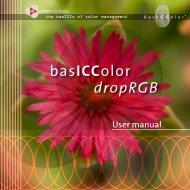basiccolor display
basiccolor display
basiccolor display
You also want an ePaper? Increase the reach of your titles
YUMPU automatically turns print PDFs into web optimized ePapers that Google loves.
asICColor <strong>display</strong><br />
by Color Solutions Software<br />
anyway. So it makes more sense to calibrate your monitor<br />
to a tonal response curve that affects the data you want to<br />
<strong>display</strong> the least: L*.<br />
The only use of a gamma calibration is a workflow with data<br />
which need to be <strong>display</strong>ed with a certain gamma or other<br />
tonal response curve (e.g. video or web design = sRGB) out-<br />
side a color managed environment. In all other cases, L* cali-<br />
bration is the better choice.<br />
sRGB IEC 1 - .1<br />
sRGB is a working space for monitor output only. You find it<br />
mainly in the areas of Internet, muli media video and office<br />
applications.<br />
The tonal response curve cannot be described with a gam-<br />
ma function (although Photoshop, for example, reports a<br />
gamma value of 2.2). In the shadows, it resemble more an L*<br />
curve, in the midtones and highlights it follows the gamma<br />
2.2 curve. In order to exactly match sRGB data, basICColor<br />
<strong>display</strong> is the only monitor calibration application that of-<br />
fers an sRGB calibration curve for these applications.<br />
5
















